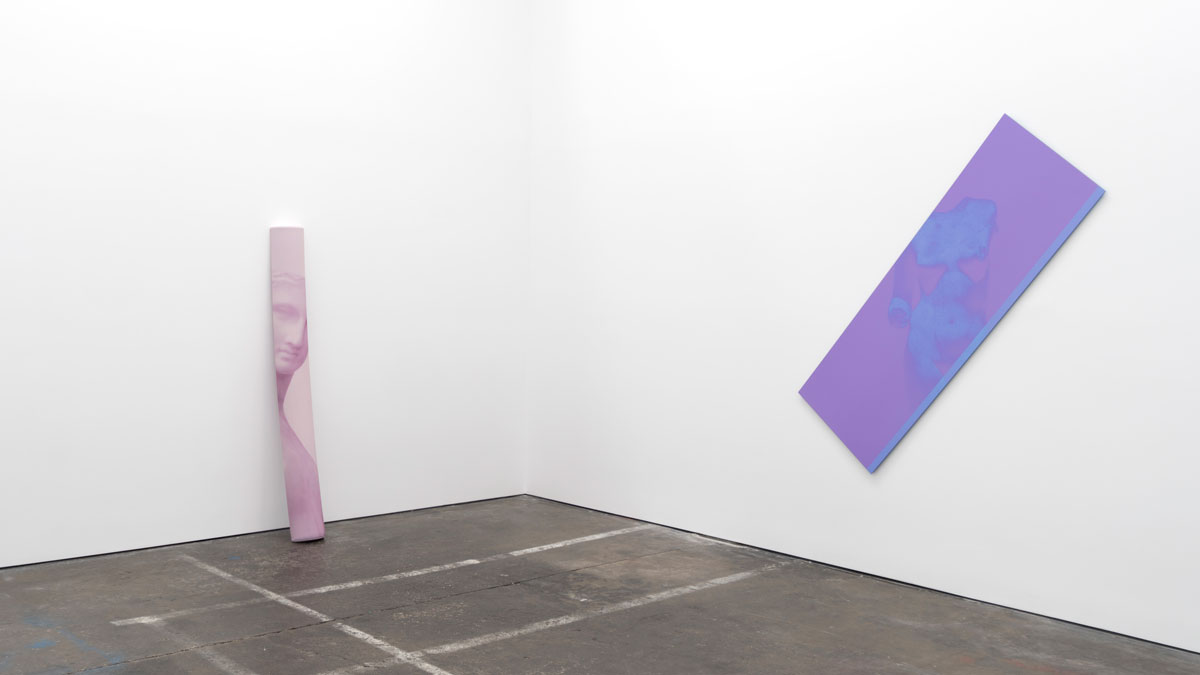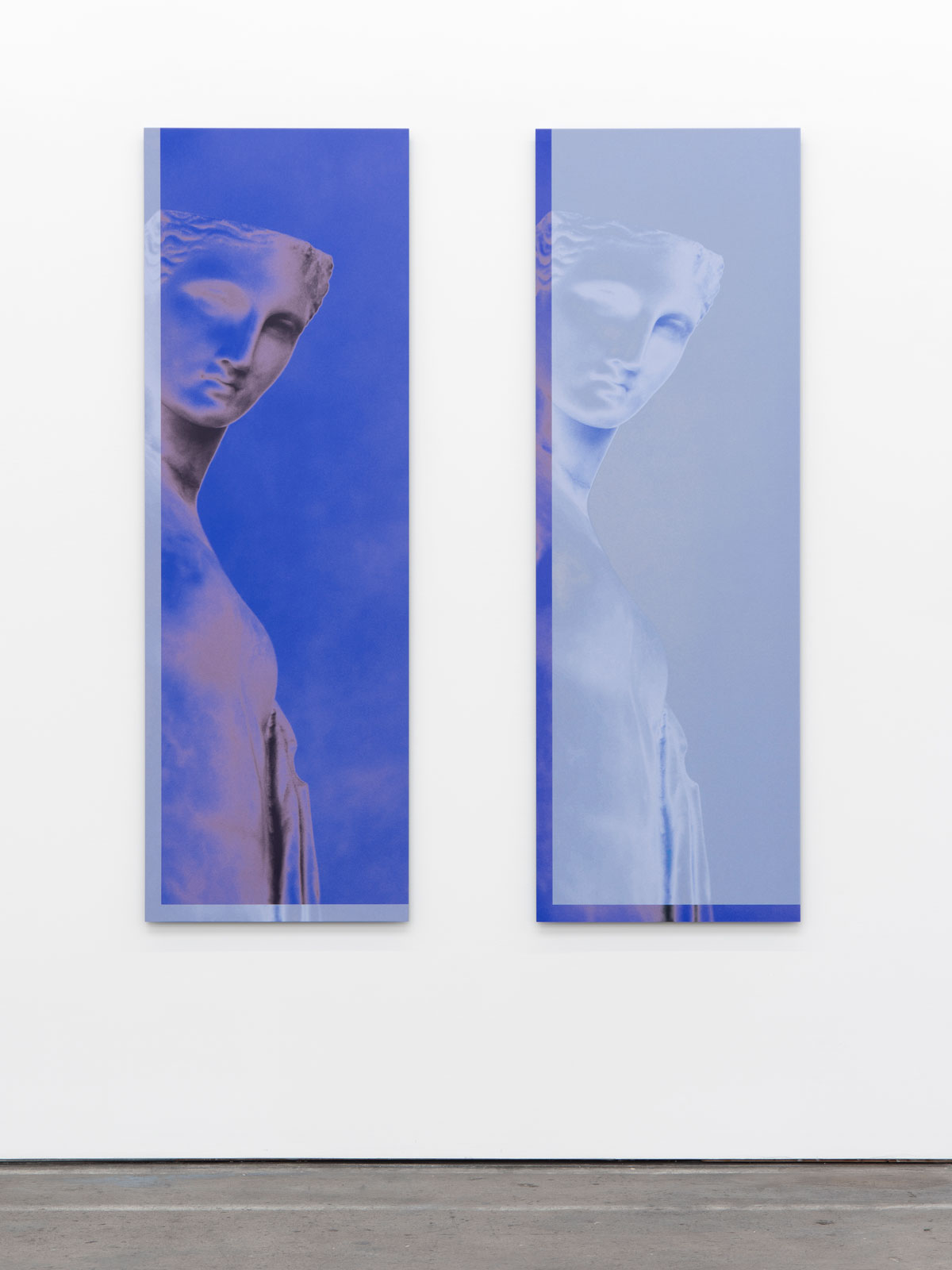Color has long been contentious—even Plato and Aristotle disagreed as to whether it helped or hindered the aim of art, which was always the imitation of nature. Color was decorative, even false, but gave painting and sculpture life, and truth. The Greeks used the word pharmakon for paint and artificial color; it also meant drug (both poison and cure), remedy, medicine, charm and spell. Color has often been associated with the marginal, the threatening—that which is not in charge—so also: the foreign, the feminine. Its definitions have included “to hide,” “to conceal,” “a pretense”; it still means to embellish, at the very least to influence.
Artist Sara VanDerBeek knows that ancient Greek and Roman marble statues were originally many-colored, vibrantly painted, and that, when antique statuary was rediscovered during the Renaissance, the brilliance had largely worn away. Figures were prized above all for their (colorless) forms. Better yet, she knows that the contemporary impact of such a revelation has less to do with the reapplication of color to the statues—as some art historians are now undertaking via plaster models or projection—than with revealing the decidedly fragmentary nature of the past and its hold on us.
In Roman Women, on view at San Francisco’s Altman Siegel gallery through Aug. 30, VanDerBeek’s saturated, synthetically colored photographic prints of Roman statues both acknowledge and render foolish our heavily conditioned assumptions about the place and virtue of unadorned white marble—and by extension the chauvinist ideals of Western empire.
Her vivid, all-over color images are further manipulated: cropped, duplicated, printed on flat metal plates and wrapped around three-dimensional objects. As such, they accentuate how simultaneously incomplete and pervasive our own understanding of the past can be, and challenge the legacies tied to art and to bodies, particularly women’s, inherited images so often carry.

In Roman Woman XI, at the gallery’s entrance, a bright and piercing lapis offsets a crouching, life-size woman entirely cast in deep and ethereal violet. She’s missing a portion of her head and both arms; she casts a shadow on her own thighs and gentle belly rolls. A thin purple strip along the left edge of the print hints at the meticulous coloring process.
Like all the 2D works, it is a dye sublimation print on aluminum, meaning the ink and image are essentially fused into the metal, making the print color-fast and UV-resistant. It’s mounted on a thin plate of colored plexiglass and frameless, hovering slightly off the gallery wall.
VanDerBeek ups her transformative techniques in Roman Woman XVIII. She’s big (48 by 66 inches), shown from the shoulders up. On a pale peach background, her skin is the color of glowing silver gelatin, her face awash in warm magenta. She’s a little blown out, contrast-wise, so that a highlight erases, a lowlight blotches. VanDerBeek shoots with film before scanning the negatives for digital editing, and the texture of the emulsion is often present in the print.
Her images work best by building depth of color, not depth of space. The layers of color are inextricable yet beg to be plied apart—you feel their additive weight without quite comprehending which is laid over what. You see the composite colors, the deep indigo, the magenta, like colored gels along the edges, and witness how at one stage VanDerBeek turned this woman blue, gray or purple.
While photographing the statues in collections and museums across Europe and the United States, VanDerBeek used only existing light, shooting from every angle. In an Aperture interview, she describes being mesmerized.
Her now-extensive image archive of classical and neoclassical figures began with a residency at the Fondazione Memmo in Rome in 2012. Her final prints, of inky blue torsos and enlarged silhouettes, have been shown in New York and, earlier this summer, in Minneapolis. The distortions of color and perspective are greater, however, in the work at Altman Siegel.

Two six-foot-tall prints feature the same woman, partially effaced in the posterization, the images identical but for their inverted colors—silver and crepuscular, cloudy purple. There’s another bust in quadruplicate, and in the next room, a face cut off by the angled slant of the print. Obfuscation and repetition highlight the paucity of certainties we possess about the way our readings of images and objects come to be, about the values we receive yet treat as full and absolute.
VanDerBeek wraps prints around a wooden pillar and foam rollers, rendering those women visible only fractionally. She turns images into objects and objects into images, a feedback loop of references and referents, of symbols and meanings.
I’ve never seen an ancient statue in all its polychromatic glory (I missed Gods in Color at the Legion of Honor in 2017), but, by looking at Roman Women, it’s possible to understand what it is we’re often missing in our encounters with antiquity, and other eras.
“This is the pharmakon,” writes poet Lisa Roberston in her essay, “How to Colour,” “an indiscrete threshold where our bodies exchange information with an environment.” VanDerBeek’s Roman women are not just in color but in conversation with their place in the cultural imagination and historical reality; they are materially critical of their inherited significations.
As a photographer interested in the properties of photography—its production, reproduction and circulation—more so than its mimetic knack, VanDerBeek reminds us that the scale of space as well as time is ever fungible, that context is crucial, that viewpoint is always limited. Might an imitation of life look different than we once thought? As we reconsider the ways in which we see ourselves, we must assert that there are no givens, not anymore.

‘Roman Women’ is on view at Altman Siegel in San Francisco through Aug. 30. Details here.



















